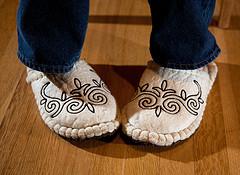Does Your Radiant Floor Heating Need Repair?
 On a frosty morning, there is nothing more luxurious than radiant floor heat, also known as underfloor heating. It quite literally warms you from your toes on up. What's more, this type of heating -- which may be based on hot water ("hydronic") or electricity -- tends to break down less frequently than other HVAC systems because it has fewer moving parts. Nevertheless, once in a while you will find that your underfloor heat is not functioning as it should. Here's how to troubleshoot radiant floor heating that is too cold or too hot.
On a frosty morning, there is nothing more luxurious than radiant floor heat, also known as underfloor heating. It quite literally warms you from your toes on up. What's more, this type of heating -- which may be based on hot water ("hydronic") or electricity -- tends to break down less frequently than other HVAC systems because it has fewer moving parts. Nevertheless, once in a while you will find that your underfloor heat is not functioning as it should. Here's how to troubleshoot radiant floor heating that is too cold or too hot.
Too Cold
Know what to expect from your underfloor heating so that you can distinguish normal operation from a malfunction.
- Be patient. This type of heating system can take anywhere from a few minutes to a full hour to warm up an entire room, so you may feel chilly for some time even after switching it on. If you'd like a toasty temperature as soon as you get out of bed or come home from work, consider installing a programmable thermostat to ensure the heat will be fully operational by the time you need it.
- Be aware. Radiant floor heating is designed to feel comfortably neutral underfoot (not hot, as you might expect) on all but the very coldest days.
- Be neat. An excess of objects on the floor, such as heavy carpet, beanbag chairs, or just plain clutter, will block the heat from circulating as it should.
If, after taking those three factors into account, you're still freezing, troubleshoot the problem according to the type of system you have. Hydronic underfloor heat temperature can usually be increased by raising the water heater thermostat. In the case of electric radiant heat, you may have a circuit overload; check your breaker board. (Frequent power failure due to overload means you should consider upgrading your panel.) In a case where the problem is not caused by your home's electrical system, your radiant floor heating may need repair or adjustment.
Too Hot
On extremely cold days, expect that your radiantly heated floor will feel warm, rather than neutral, to the touch; this is nothing to worry about.
However, if the flooring gets uncomfortably hot, it might be a sign that your radiant floor heating system requires repair.
The most common cause is that the temperature of the water entering the system is too high. The maximum recommended is 130-140 F. A mixing valve will reduce the heat of water coming from your boiler, if necessary.
Another reason an electrically heated floor may become overly hot is that the radiant heat is trapped (for example, when a large appliance is positioned over a portion of the system) and not permitted to dissipate into the air.
If neither of these DIY fixes solves the issue, contact a reliable HVAC service person. When a hydronically heated floor becomes overly hot, it can be dangerous to humans or animals walking on the surface. In addition, excessive heat will raise your operating costs, shorten the life of your heating system, and possibly damage the flooring.
Just Right
The normal temperature for radiant heating is 75 F at floor level and several degrees higher on very cold days. This means that you will usually feel comfortable walking barefoot on your radiantly heated floor … and your pets will love it! Another advantage of this type of setup is that it will radiate heat at a steady pace, rather than in occasional blasts, as with forced air heating. However, it's important to be aware that as the warmed air rises, it will be cooler than on the floor. A 75 degree floor temperature will work out to approximately 68 F at adult head level, and 61 F at ceiling height.
Laura Firszt writes for networx.com.
Updated June 14, 2018.
Looking for a Pro? Call us (866) 441-6648

Heating & cooling Average Costs
HVAC Contractors Experiences

My HVAC Installation: A Match Of The Right Contractor And The Right Price

Restaurant Ceiling Fan Installation To Beat The Florida Heat



